I had been wanting for a long time visit the province of Jaén, because it is the land of my ancestors and due to various circumstances, I did not know it.
I decided to start the trip knowing Baeza and, together with Ubeda, which I also visited, turned out to be a wonderful surprise.
Baeza It is located in the geographical center of the province, 48 km from Jaén, surrounded by a green sea of olive trees in the region of the Hill.
Curiously, you will not find the typical Andalusian town with white houses.
Baeza takes you back in time to medieval times, and its silent streets of golden stone, its numerous palaces and its beautiful squares, will make you spend an unforgettable time walking through it and learning about its long history.
Since 2003 it has been declared, together with Ubeda, Heritage awarded by the Unesco.
All the information in detail
- 1 Curiosities of the history of Baeza
- 2 What to see and do on the Baeza tourism visit
- 2.1 Baeza Cathedral
- 2.2 High Town Hall Houses in Baeza
- 2.3 TOURS and EXCURSIONS in BAEZA and UBEDA
- 2.4 Fountain of Santa María in Baeza
- 2.5 Aliatares Tower in Baeza
- 2.6 Plaza del Populo or Plaza de los Leones in Baeza
- 2.7 Old Butcher Shop in Baeza
- 2.8 Civil Hearing and Public Notary Offices in Baeza
- 2.9 Villalar Arch and Jaén Gate in Baeza
- 2.10 Jabalquinto Palace in Baeza
- 2.11 Seminary of San Felipe Neri in Baeza
- 2.12 Old University of Baeza
- 2.13 Church of Santa Cruz in Baeza
- 2.14 Baeza Town Hall
- 2.15 Museum of Olive Culture in Baeza
- 3 Gastronomy: what to eat typical in Baeza
- 4 Map: how to get to Baeza
Curiosities of the history of Baeza
The origins of Baeza go back to the Bronze Age and cultures such as the Iberian, the Roman, the Visigothic and the Muslim have passed through it.
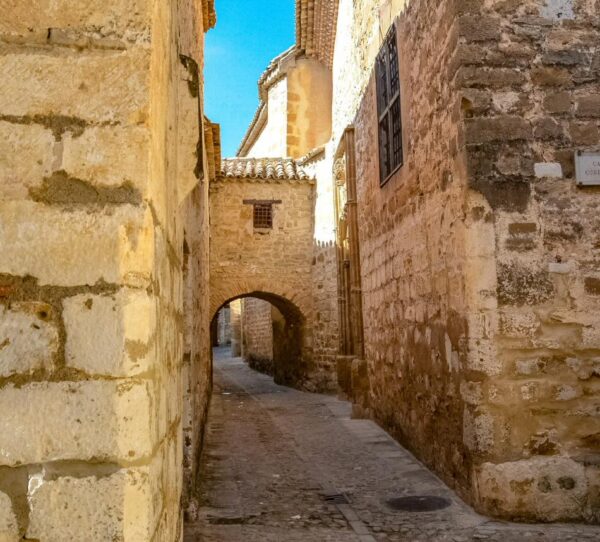
During the Muslim era it was the capital of an extensive territory that went from Guadalquivir a Sierra Morena, thus becoming the most important city in the province of Jaén, after the capital.
It had intense commercial activity, with numerous souks and bazaars, until in 1227 it was conquered by Ferdinand III the Saint.
His intervention was decisive in the entire reconquest of Al Andalus, which is why it became known as Hawks Nest.
If it was important in the Muslim era, when it really acquired its greatest splendor was in the 16th and 17th centuries, both in its activity in agriculture, livestock and industry, and at a cultural level.
At this time they created the Baezana University and most of the city's civil and religious monuments.
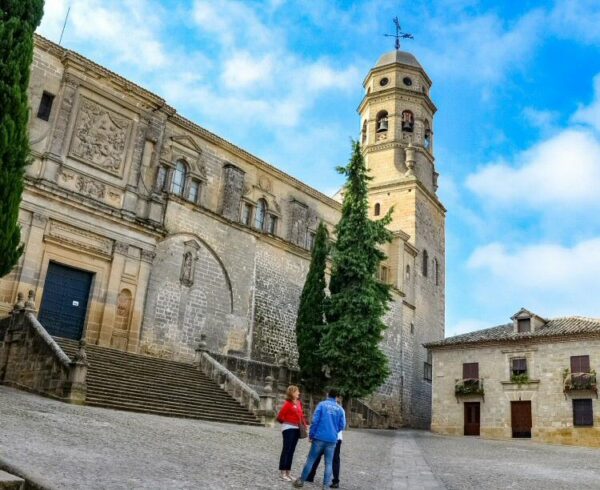
San Juan de la Cruz o Saint John of Avila were some of the many illustrious people who passed through Baeza.
Since the 16th century, the nerve center of the city has been the large porticoed plaza, where the names of the old union groups are still preserved and where the city festivals were celebrated.
As a curiosity, I can tell you that many historical films have been filmed here, including the Captain Alatriste, scenarios that you perfectly imagine walking through its streets.
What to see and do on the Baeza tourism visit
When I considered taking this trip, I decided that the best thing was to sign up for a tour to visit Baeza, whose guide was super friendly and gave us a very enjoyable tour.
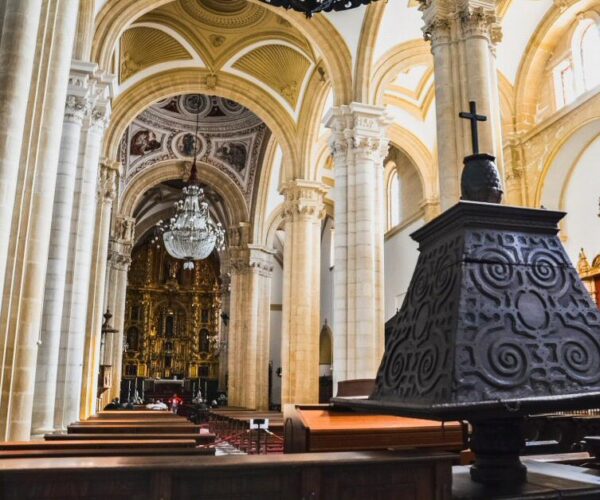
In a couple of hours you are perfectly situated in the city, and then on my own I dedicated myself to enjoying its corners and delving into what interested me most.
Here I tell you what the most interesting places to see and visit in Baeza, where after meeting them I already warn you that you will be left wanting to return.
Baeza Cathedral
This Andalusian province has two cathedrals, one in Jaén capital and another one in Baeza, and the bishop spends six months in each of them.
This magnificent cathedral It is located in the place where the old mosque was located.
With the input of Alfonso VII in the city in the 12th century, the conquest of Baeza and a small church begins to be built in the same place where the mosque was located.
ORGANIZE your TRIP
- Don't forget your TRAVEL INSURANCE with a 5% discount
- Book the HOTEL for your trip
- RENT a CAR for your trip
- The best TOURS and EXCURSIONS in Spanish
- NO-LINE TICKETS for museums and monuments
- Best FREE TOURS around the world
- Book your TRANSFER from the airport
- eSIM card with INTERNET at the best price
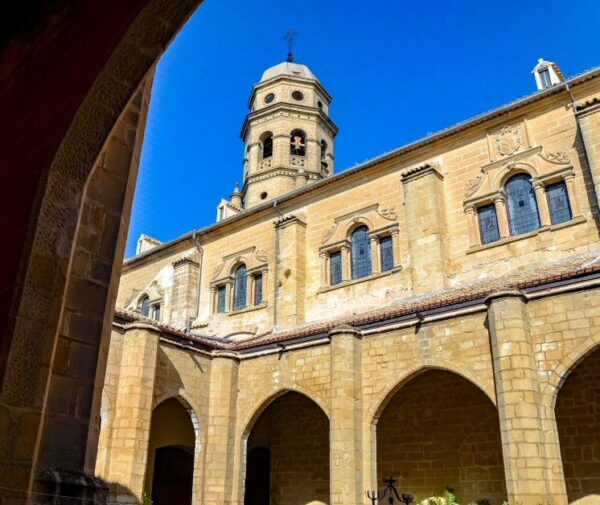
Went with Ferdinand III the Saint In the 13th century, when the city was already Christianized, the construction of the cathedral began and it was consecrated as a Christian temple.
Andres de Vandelvira, the most prestigious Renaissance architect of the time, was in charge of its subsequent reconstruction.
What you are going to see in the cathedral is a pure rebirth, although with remains of other styles that have been preserved.
These remains can be seen in vaults or in the 14th century Gothic rose window found on the west façade of the cathedral, Above the Moon Gate, through which you will access the interior and the cathedral cloister.
On the south wall you will find the Door of Forgiveness, also in Gothic style, and on the main façade, the Nativity Cover.

The temple is divided into three naves covered with hollow vaults; of tracery are only those of the transept and those of the chevet.
Although it has many chapels and all of them are interesting, those of San Jose and golden chapel designed by Andres de Vandelvira.
Upon entering you will see a beautiful grille with double reliefs, with a lot of iconographic decoration, and at the top of it, the image of the Madonna and Child.
This fence enclosed the old choir that was removed in the 20th century.
La Processional Custody, is declared A Cultural and it is one of the most important pieces of the cathedral.
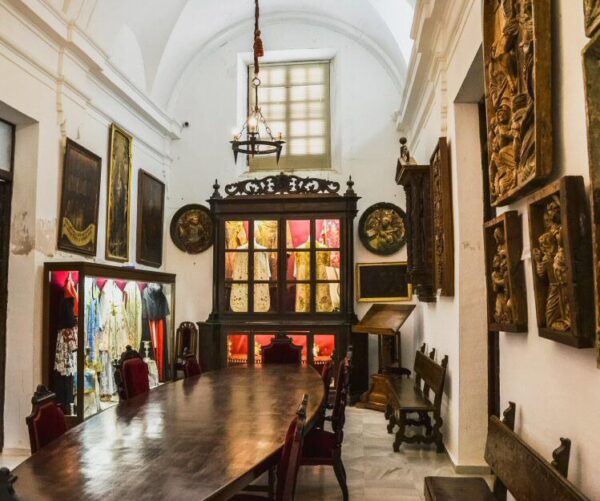
With a height of 2,20 meters, and a very special meaning for the baezanos, is a very fine jewel of baroque art chiseled in silver with some areas of copper.
The altarpiece is also baroque, and consists of two bodies and three streets separated by Solomonic columns; In the upper body you have the figure of San Andres as patron of the city.
For visit this monumental city, you can sign up for this Free Tour of Baeza with an hour and a half duration, and as an alternative, here you go other free tours to choose from
The sacristy was built in the place where there were three other chapels, and has a very beautiful entrance door of plateresque style, Door of San Andrés.
La Baeza Cathedral It has a cloister with a rectangular floor plan and a tall body, which you access from the inside.
From the cloister you can visit the Cathedral Museum, with different rooms where you can see objects of great value both in furniture and religious clothing or paintings.
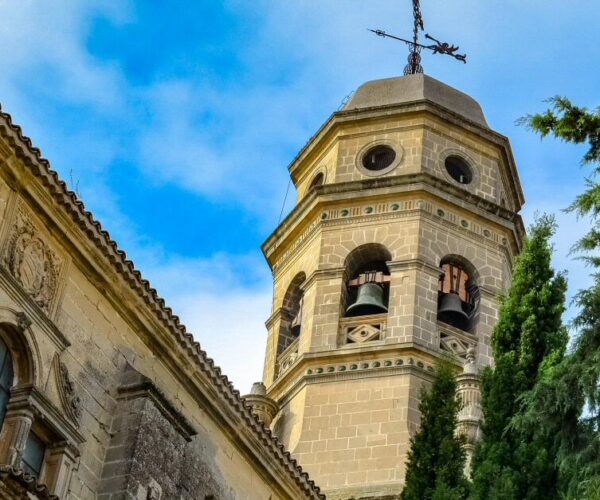
La cathedral tower It was originally the minaret of the mosque; It has a square floor plan, with granite shafts on the edges.
On the outside of the cathedral tower You can see in each corner three of these four granite columns that it has.
Legend says that people who are of marriageable age have to pass their hand on full moon nights through one of them, the one you will see most pierced, and within a year their wish will be fulfilled.
Don't forget your Travel Insurance
Are you organizing your trip or getaway? Don't leave without take out your travel insurance before, and here we explain why. If you hire it with us, you have a 5% discount
High Town Hall Houses in Baeza
This historic building is located next to the cathedral, attached to it as if it were part of it.
Was the manor house of the Cabreras, was given to Baeza Council at the beginning of the 16th century, and from then on it became Town Halls, one of the most beautiful and traditional buildings in the city.
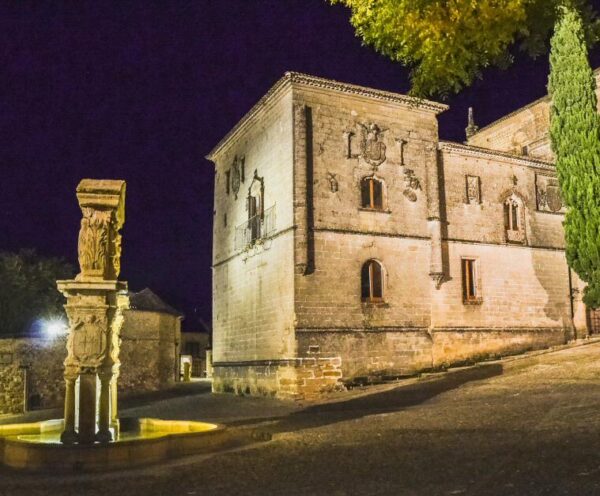
The west façade shows the Gothic entrance door and two Gothic windows, among which are the royal coats of arms of Joan the Crazy y Philip the Beautiful.
On the north façade you will see a beautiful balcony, and on one side of it, the imperial coat of arms of Carlos V.
Currently the building is used by the Conservatory of Music.
TOURS and EXCURSIONS in BAEZA and UBEDA
- Guided tour in Baeza
- Guided tour in Ubeda
- Ubeda and Baeza in full
- Night tour in Baeza
- Private tour in Baeza and Ubeda
Fountain of Santa María in Baeza
You will find this great fountain as soon as you enter the Plaza de Santa María, in a privileged location between the cathedral, High Town Halls and Seminary of San Felipe Neri.
It was built in the mid-16th century by the teacher and architect from Baeza Ginés Martínez and they say it is one of the most beautiful fountains in Andalusia.
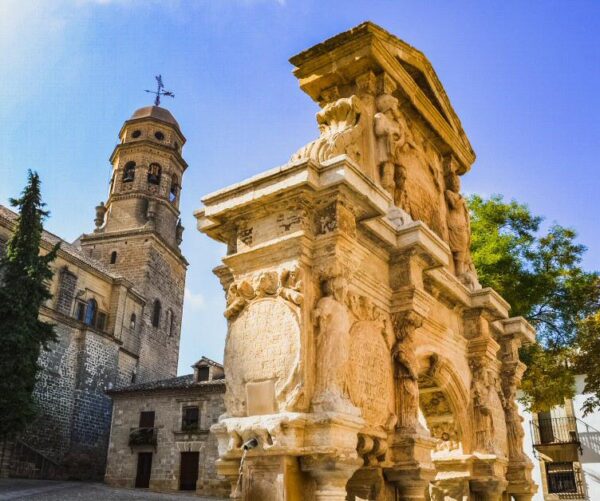
You will see a construction of type Renaissance with a lower body in the shape of a Roman triumphal arch, with three openings, and a structure of columns with two fronts and eight caryatids on the pilasters.
The upper part ends with a classic pediment where you can see the coat of arms of Felipe II and that of the city protected by two Atlanteans.
The water in the fountain came from Celadilla Mine, which was excavated in the plains plateau located northwest of the city.
When the water reached the city, it was accumulated in a large tank, also called Water Ark, and from there, through pressure pipes, they took the water to the different public fountains that were around. Baeza.
Aliatares Tower in Baeza
It is also known as Clock Tower and is located in the historic center of Baeza.
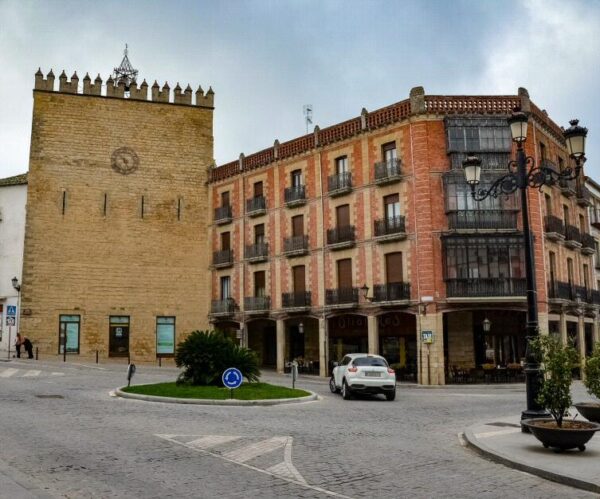
If you don't look closely, it is possible that this tower goes unnoticed, since on its sides it has more recent constructions, and you could be under it and not realize it.
It is an Arab tower that is part of the old Muslim wall from the 12th century, and from it the missing wall was defended. Cañuelo Gate and the next one Barbican.
Book your hotel, 15% discount, free cancellation
When planning your trip, we advise you to, well in advance, Book your hotel now on booking.com where you can find discounts from 15% and you will have a possible cancellation for free
Rectangular in plan and 25 meters high, it has been restored on several occasions.
On the façade you will see a clock that was placed in the 19th century, as well as the battlements that are from the last century, imitating those of the Villalar Arch.
This tower has been a prison for nobles, a recruitment center and even a dovecote.

Plaza del Populo or Plaza de los Leones in Baeza
It is one of the most charming squares it has. Baeza.
presides over the square Fountain of the Lions, an archaeological monument that comes from the Roman city of Castulo.
The female figure that crowns the fountain is the Iberian princess Imilce, who was Hannibal's wife, who is protected by four lions located at her feet.
For the city of Baeza This fountain symbolized the pride of having become a place where the nobility and the clergy went.
The tallest buildings of the time were concentrated here, such as the old butcher shop and Civil Hearing and Public Notaries what is the current tourist office.
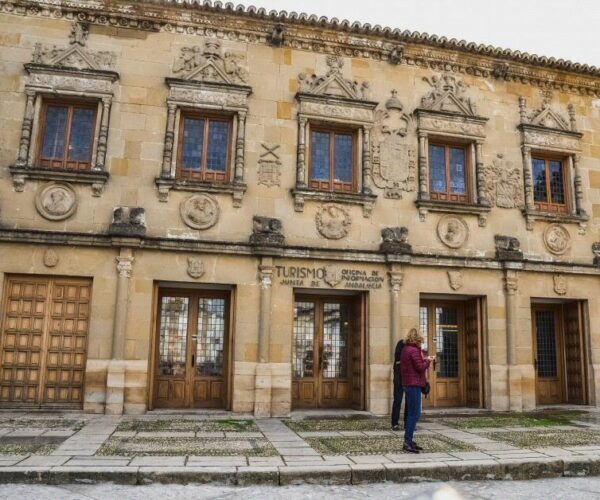
Old Butcher Shop in Baeza
La old butcher shop It has had many uses throughout history, as it was a drying room for skins, a historical archive and museum, as well as the headquarters of the Youth and Sports Board, and is currently the headquarters of the Courts.
The façade is made up of two very different bodies.
Reserve your RENTAL CAR now for your trip
Looking ahead to your trip, book your rental car now on this website that offers you the best price guaranteed and allows you a possible free cancellation in most cases. Here you have more information with tips for renting a car
In the first you will see a lintel door and three windows with bars, and in the second, a viewpoint with square pillars, and in the center, a large imperial shield.
Civil Hearing and Public Notary Offices in Baeza
The building of the Civil Hearing and Public Notaries was once called House of the Populo since on one of its balconies the image of the Virgen del Pópulo.
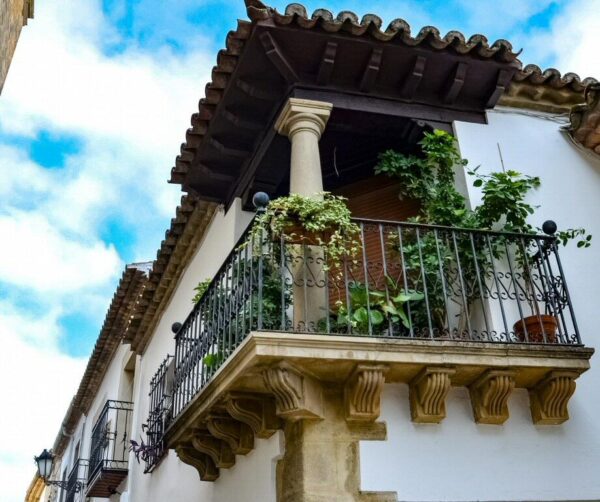
Today the image does not exist, but legend says that when the Baeza warriors went to fight against the Muslims, they made a stop to prostrate themselves before it.
It is in the Plateresque style and was built by breaking the Muslim wall that was just behind it.
It consists of two floors, and in the lower section you will see six lintel openings between attached columns with seven lying lions and six shields of the city.
In the upper body there are imperial shields and that of the magistrate, as well as some windows with balustraded columns.
Villalar Arch and Jaén Gate in Baeza
A corner that will surely catch your attention when you enter the Plaza del Pópuloit's el Villalar Arch and the Jaén Gate.
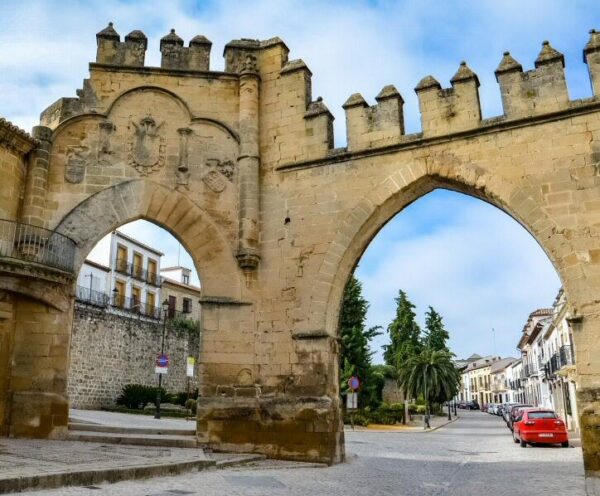
These are two adjacent passages that opened in the wall, the arch being built to commemorate the Battle of Villalar in which the troops of Carlos I They defeated the commoners of Castile.
Jabalquinto Palace in Baeza
This beautiful building declared a historical-artistic monument has a beautiful façade of style Elizabethan Gothic, which is what will catch your attention the most and will remind you of the house with the towers of Ubeda for its decoration.
It is located next to Seminary of San Felipe Neri and is currently part of the headquarters of the International University of Andalusia Antonio Machado.
It was ordered to be built in the second half of the 15th century by a cousin of Ferdinand the Catholic, Juan Alfonso de Benavides Manrique, Lord wild boar.
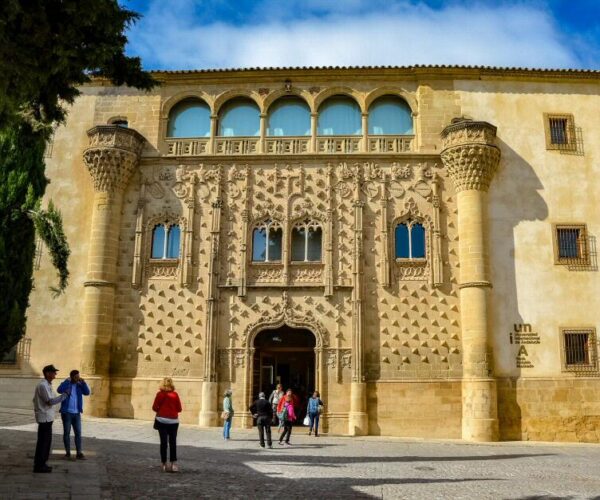
As a curiosity to tell you that the poet's daughter jorge manrique she married the son of Marquis of Jabalquinto.
The building has had many uses, it was a student residence and school, a rehabilitation workshop. Baeza Heritage.
On the façade, the large number of pinnacles and the heraldic shields of the founders stand out.
Inside you find a Renaissance courtyard with a double arch, with marble columns and shields in the spandrels, except for the corner ones where you will see couples of children, and an impressive imperial-type baroque staircase with lots of decoration and the half-orange vault. .
Seminary of San Felipe Neri in Baeza
You will find the old seminary building right in front of the Baeza Cathedral and since 1969 it has been the headquarters of the International University of Andalusia Antonio Machado.

It was founded in 1660 by bishop Fernando de Andrade y Castro.
Like all these buildings, it has undergone many renovations, the most important being the one carried out in 1990 to convert it into a University.
On the outside that faces the Santa Maria square, you can see a very sober façade, almost without decoration, and social criticism of the time appears on its walls in inscriptions made by the students themselves.
On this façade there is the main semicircular door framed by pilasters and a split pediment at the top.
The door that leads to the other facade is closed and above it you can see the stone figure of Saint Philip Neri.
The interior is distributed around three patios with columns, two of them with galleries.
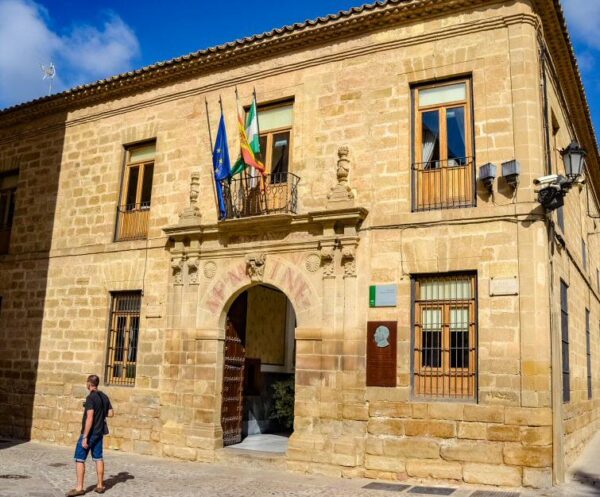
Old University of Baeza
At the end of the 16th century, long before the universities of Jaén or Úbeda were founded, the intellectual and scholarly spirit of the people of Baeza led them to create their own university.
It is one of the fabulous buildings of civil architecture in Baeza and one of the few of mannerist style de la ciudad.
The structure is typical of renaissance palaces, with a double-arched patio and a covered staircase.
In the patio there is the Auditorium o Assembly Hall, which surprises with its impressive acoustics.
The first graduations date back to 1549, and these students became professors at the University, which for a long time was the best in Andalusia.
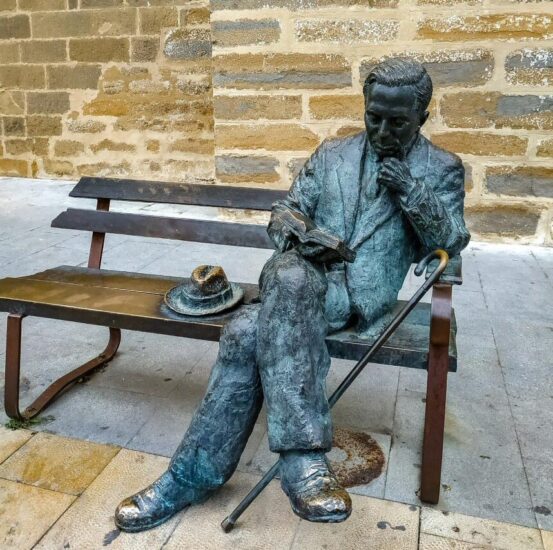
Over time and due to the parochial nature of the University of Baeza, a phenomenon of exaltation occurred among the students that became known as “the lightings.”
As a consequence, the Court of the inquisition and imprisoned the most prominent professors.
It is currently a secondary school, a place where Antonio Machado He taught French grammar for seven years.
It is very curious to see this classroom that no time has passed through and that is preserved as it was when he was a teacher.
En Baeza He wrote some of his famous poems such as “the gray olive groves" or "the cheerful fields of Baeza".

Church of Santa Cruz in Baeza
In front of Jabalquinto Palace you will find this church romantic style, which has been preserved in perfect condition.
It dates back to the end of the 13th century and the reason for its construction was the conquest of Baeza by Ferdinand III the Saint.
The main façade was covered by neoclassical structures and is seen in the decoration of the column capitals.
Inside this small church, the Mudejar roof was changed to the one it currently has since it was very deteriorated.
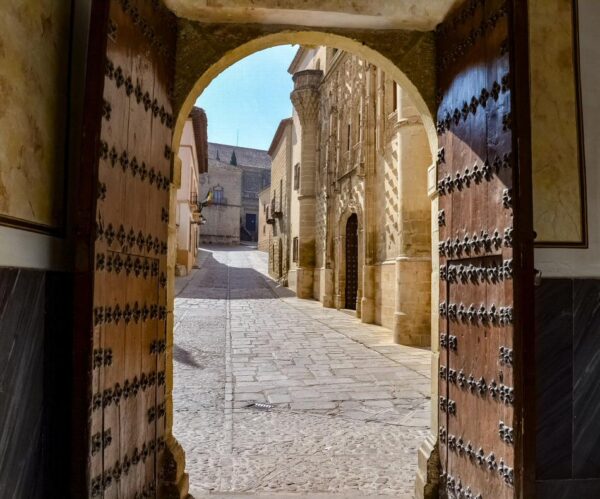
It is divided into three naves with wooden coffered ceilings that are supported by stone columns.
The central nave ends in a barrel vault and a semicircular apse covered with fresco paintings dating from the beginning of the 16th century.
The walls and the apse are made of masonry, and it also has a Visigothic arch inside which is preserved from previous buildings.
Baeza Town Hall
The building that currently houses the Baeza Town Hall is a plateresque style palace which was used as a prison and Baeza House of Justice.
It is declared National Monument and it is one of the most original and valuable buildings of the Andalusian Plateresque.
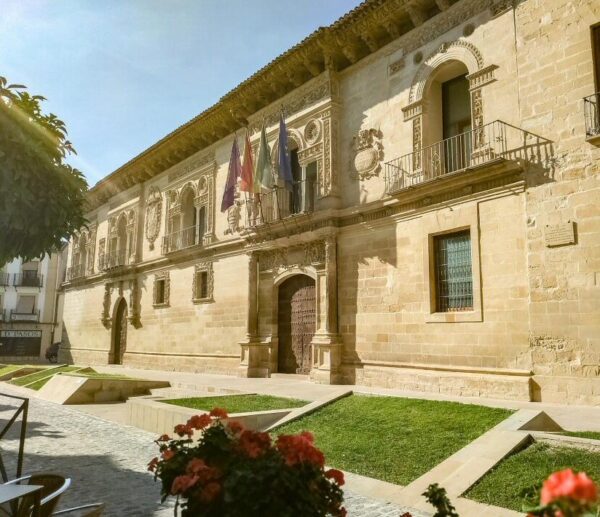
In its lower body two doors open, the one on the left gave access to the old prison, and the one on the right, to the House of Justice.
At the top there are four balconies with various shields between them, and on the cornice you can see figures of children, sphinxes, eagles and acanthus leaves.
Inside the town hall, look at the Renaissance plasterwork in the lobby, as well as the Renaissance coffered ceiling in the Plenary Hall.
In front of the town hall is the house where he lived Antonio Machado during the seven years he resided in Baeza, as indicated on a plate.
Walking through the city you will find many palaces that today are hotels or centers dedicated to various activities.

Museum of Olive Culture in Baeza
Being in Baeza You can't stop knowing everything related to oil culture, for which you can visit the Olive Culture Museum.
And of course, you can also sign up for one guided tour of an oil mill, where you can see how the oil is made, as well as taste its different varieties.
You will not regret these visits, in addition to leaving an expert.
Gastronomy: what to eat typical in Baeza
In the large porticoed square of Baeza you will find many restaurants where to enjoy the delicious gastronomy of Baeza, always seasoned with extra virgin olive oil.
El Baezana-style cod, daggerboard loin, pipirrana, Ajíli-mojíli are some of the typical dishesAs well as ochios that you can buy in bakeries and pastry shops, both in its salty version with paprika and sweet with sugar.
We can't forget about typical sweet from Baeza, the Virol, a puff pastry that is covered in sugar and whose recipe is a well-kept family secret.
Map: how to get to Baeza
Baeza is located half an hour north of the city of Jaén, just over four hours south of cities like Madrid and Valencia, and two and a half hours north of Seville.




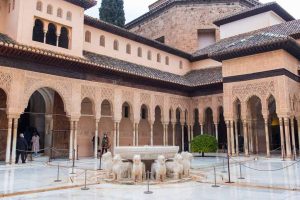
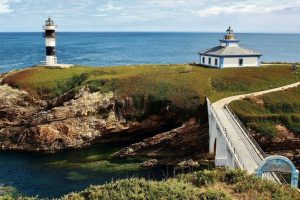











Very complete. I was in Baeza many years ago. Is beautiful. I hope to return.
Very good article and very complete. Shows what to visit in my city (although if you return, also visit the three parishes or the Conento de la Encarnación)
There's just something that doesn't add up to me. He talks about the ochíos of Holy Week, as if they were typical of that time. That is not like that. Ochios are eaten all year round, in all bakeries and pastry shops you can buy them daily, they are placed in many bars, filled, as a tapa. What is typical during Holy Week are the hornazos and vigil empanadas.
Very good guide. I was just in Baeza this morning and I loved it. The entire city is beautiful, it has some extraordinary and well-kept monuments.